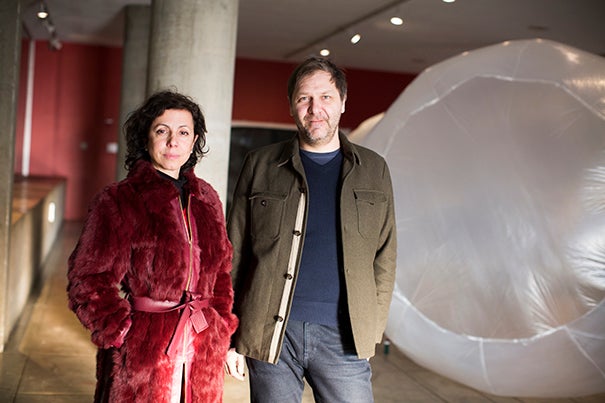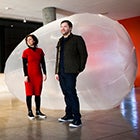
The Carpenter Center installation was created by Silvia Benedito, an assistant professor of landscape architecture at the Harvard Graduate School of Design, and architect C. Alexander Häusler.
Stephanie Mitchell/Harvard Staff Photographer
‘Pneuma(tic) Bodies’ at Carpenter Center
Movement, air, space together
Small cooling ventilators continuously inflate three large balloon-like forms, causing the soft, translucent surfaces to tremble slightly.
The thin plastic sculptures share a space with large-scale images of varying degrees of glossy black paint on paper on Level 1 of the Carpenter Center for the Visual Arts.
The sculptures and drawings are part of “Pneuma(tic) Bodies,” which opens today with a 6 p.m. dance performance featuring Jill Johnson. The exhibit continues through Feb. 21.

The installation was created by Silvia Benedito, an assistant professor of landscape architecture at the Harvard Graduate School of Design (GSD), and architect C. Alexander Häusler. It is an extension of the GSD conference “On Atmospheres: Spaces of Embodiment.” The conference explores the relationship of the body, objects, and architectural space through the enveloping medium of air.
Integral to the project is the collaboration with the Carpenter Center, GSD, the Dance Department, and the Harvard University Studio for Electroacoustic Composition (HUSEC). The exhibit opening not only includes feature Johnson, a dancer, choreographer, and director of dance, but also Hans Tutschku, composer and director of HUSEC. The two will “simultaneously respond through bodily, sonic, and sensorial engagement with the objects and space.”
Movement is fundamental to the installation. The globular forms, or “bodies,” as Benedito and Häusler call the balloon sculptures, move subtly in response to shifting air currents caused by visitors coming and going, doors opening and closing. Additionally, the drawings, though installed on the flat surface of walls, encourage physical interaction from viewers. Their shifting surface properties become visible only when moving from various angles and distances.
Scale matters, too. The drawings are about 6½ feet tall, ranging in width from 9 to 11 feet, as if exposing the scale and reach of the human body. In addition to the drawings, the large sculptures also challenge scale. The Carpenter Center was designed by master architect Le Corbusier, who developed the concept of “Modulor,” an ideal system of proportions relating the human body to the architectural environment. Here, relating the body to the sculptures creates a sense of space rather than a rigid architectural schema.
For more information, check out the Carpenter Center’s website.




